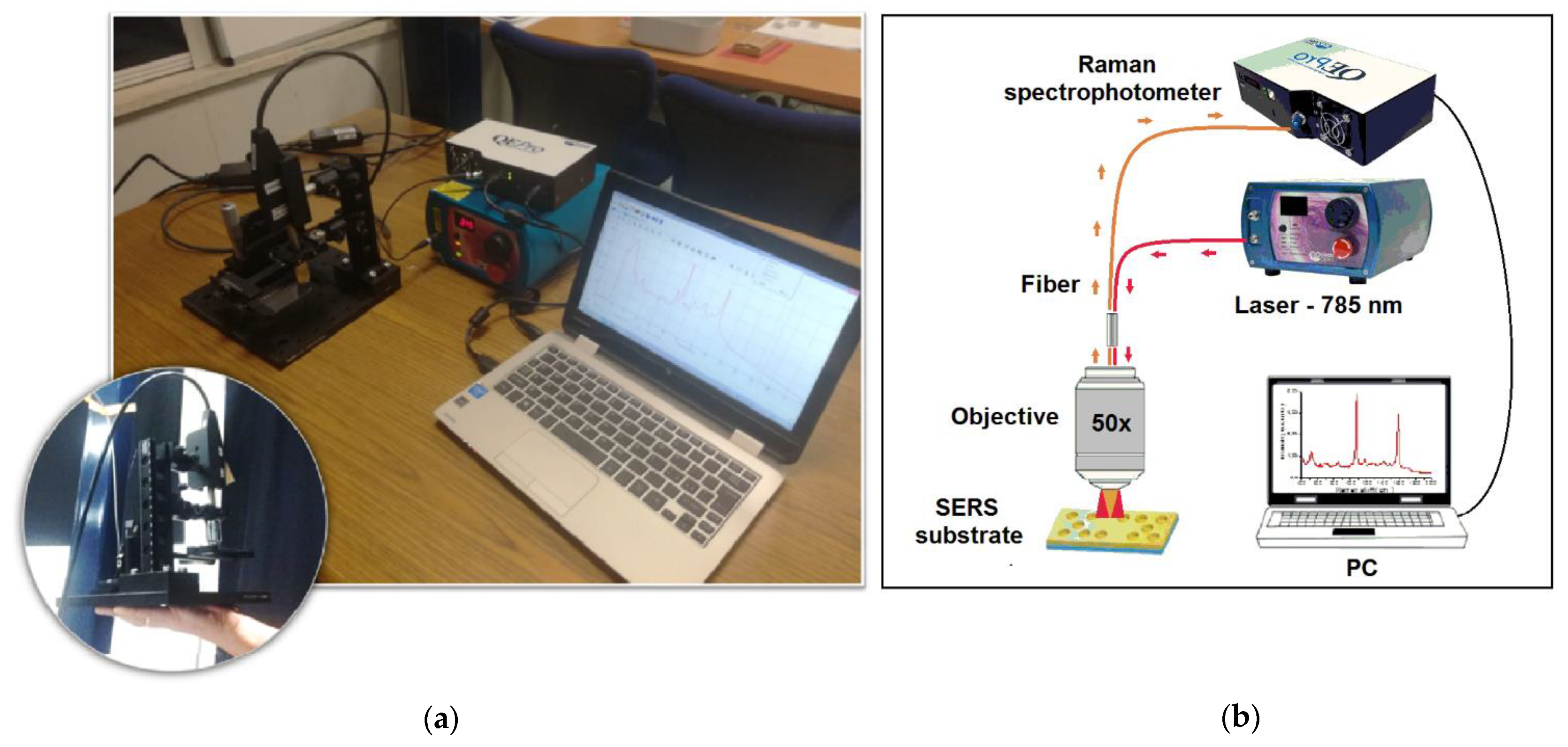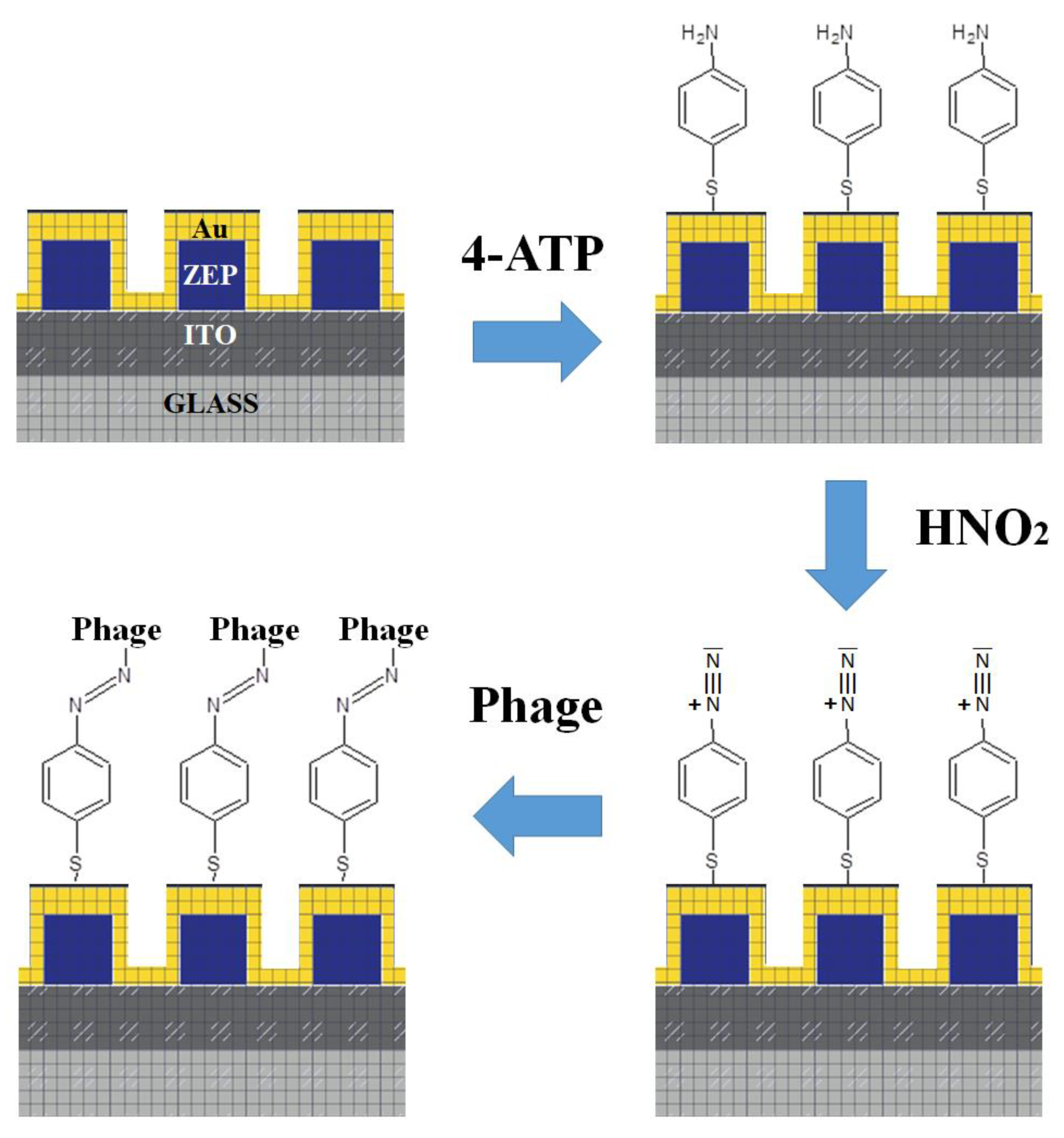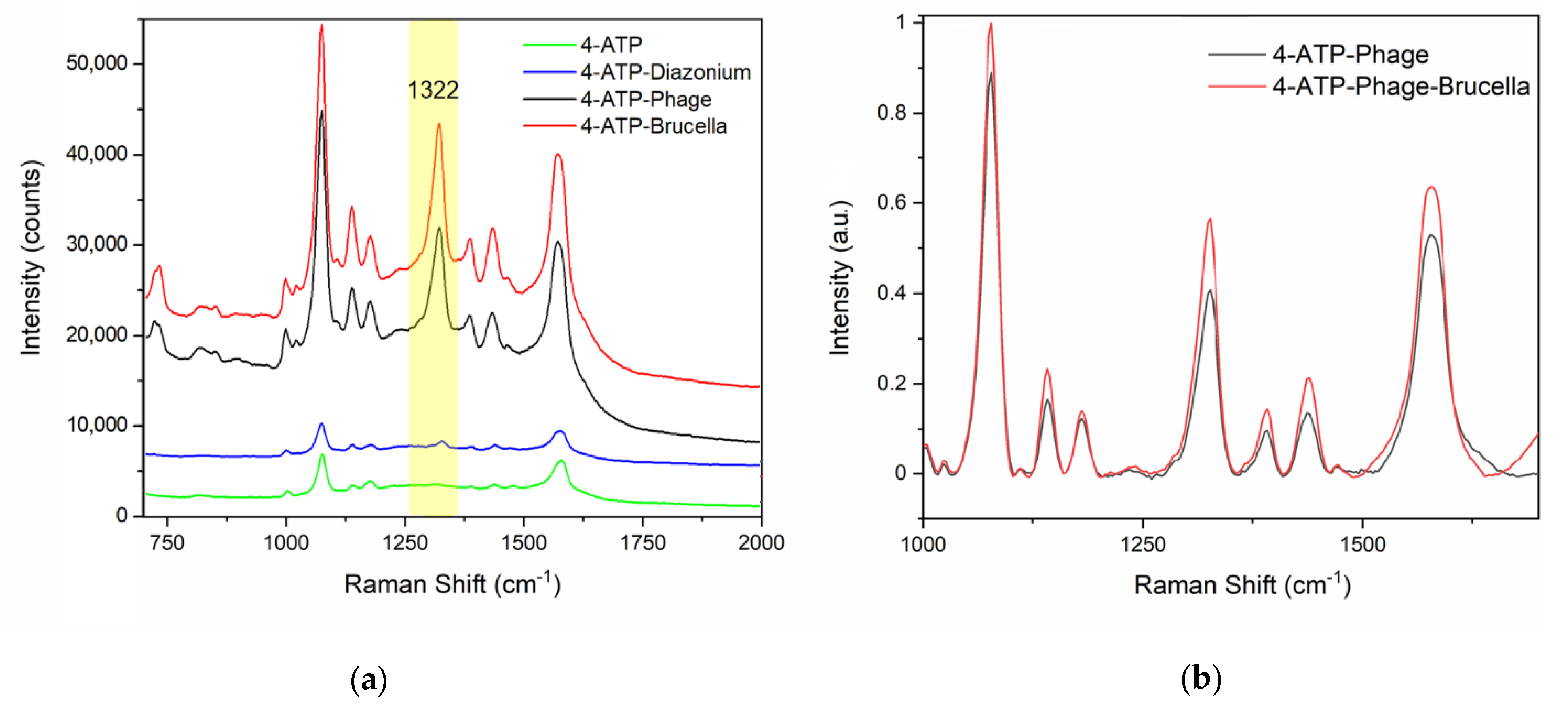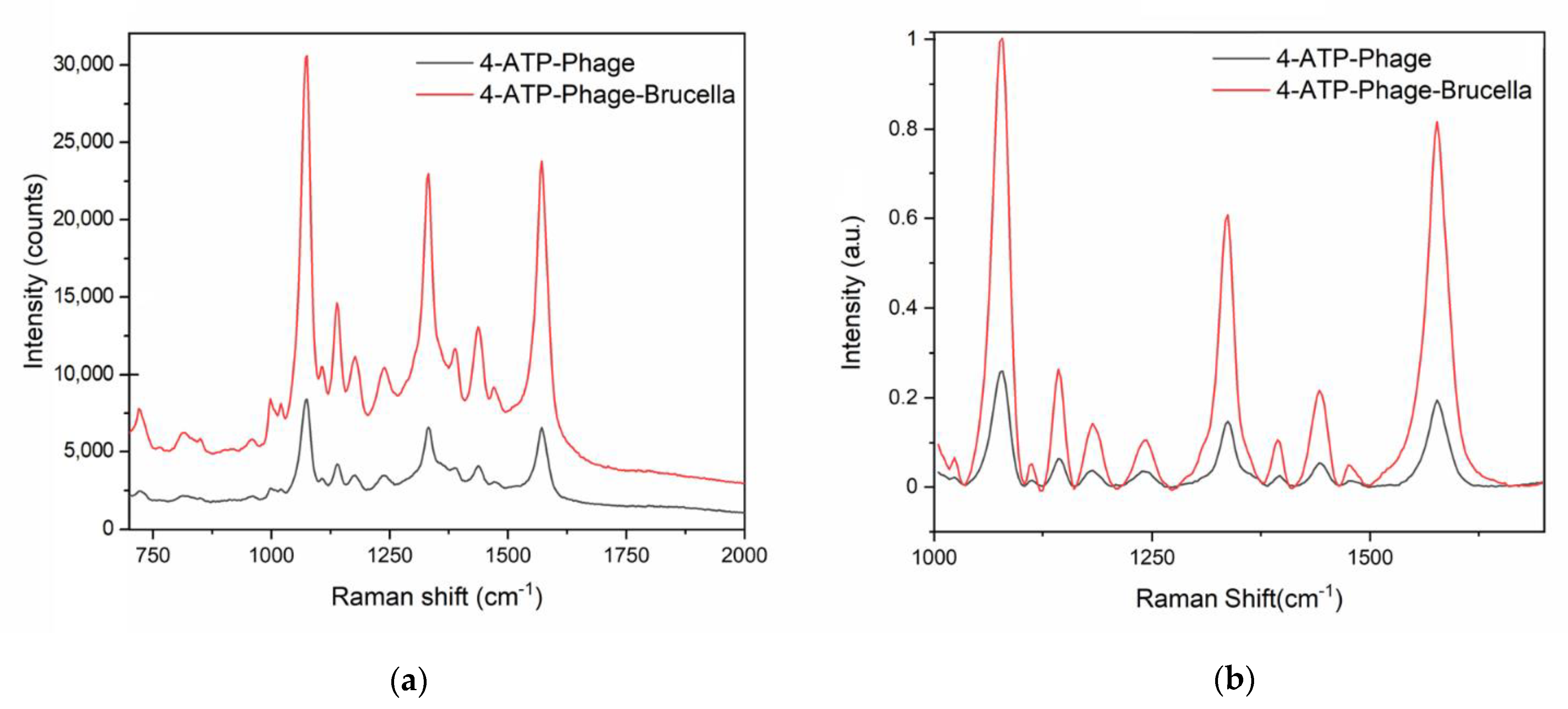SERS Biosensor Based on Engineered 2D-Aperiodic Nanostructure for In-Situ Detection of Viable Brucella Bacterium in Complex Matrix
Abstract
Author Contributions
Funding
Informed Consent Statement
Data Availability Statement
Acknowledgments
Conflicts of Interest
References
- McDermott, J.; Grace, D.; Zinsstag, J. Economics of Brucellosis Impact and Control in Low-Income Countries. OIE Rev. Sci. Tech. 2013, 32, 249–261. [Google Scholar] [CrossRef]
- Redkar, R.; Rose, S.; Bricker, B.; DelVecchio, V. Real-Time Detection of Brucella Abortus, Brucella Melitensis and Brucella Suis. Mol. Cell. Probes 2001, 15, 43–52. [Google Scholar] [CrossRef] [PubMed]
- Negròn, M.E.; Tiller, R. Centers for Disease Control and Prevention. CDC Yellow Book 2020: Health Information for International Travel; Chapter 4—Brucellosis; Oxford University Press: New York, NY, USA, 2017. [Google Scholar]
- Mccutcheon, K.; Bandara, A.B.; Zuo, Z.; Heflin, J.R.; Inzana, T.J. The Application of a Nanomaterial Optical Fiber Biosensor Assay for Identification of Brucella Nomenspecies. Biosensors 2019, 9, 64. [Google Scholar] [CrossRef] [PubMed]
- Gupte, S.; Kaur, T. Diagnosis of Human Brucellosis. J. Trop. Dis. 2016, 4. [Google Scholar] [CrossRef]
- O’Callaghan, D. Human Brucellosis: Recent Advances and Future Challenges. Infect. Dis. Poverty 2020, 9. [Google Scholar] [CrossRef]
- Meisel, S.; Stöckel, S.; Elschner, M.; Melzer, F.; Rösch, P.; Popp, J. Raman Spectroscopy as a Potential Tool for Detection of Brucella Spp. in Milk. Appl. Environ. Microbiol. 2012, 78, 5575–5583. [Google Scholar] [CrossRef]
- Hans, R.; Yadav, P.K.; Sharma, P.K.; Boopathi, M.; Thavaselvam, D. Development and Validation of Immunoassay for Whole Cell Detection of Brucella Abortus and Brucella Melitensis. Sci. Rep. 2020, 10. [Google Scholar] [CrossRef]
- Projahn, M.; Hammerl, J.A.; Dieckmann, R.; Dahouk, S.A. A Proof of Principle for the Detection of Viable Brucella Spp. In Raw Milk by qPCR Targeting Bacteriophages. Microorganisms 2020, 8, 1326. [Google Scholar] [CrossRef]
- Wu, H.; Zuo, Y.; Cui, C.; Yang, W.; Ma, H.; Wang, X. Rapid Quantitative Detection of Brucella melitensis by a Label-Free Impedance Immunosensor Based on a Gold Nanoparticle-Modified Screen-Printed Carbon Electrode. Sensors 2013, 13, 8551–8563. [Google Scholar] [CrossRef] [PubMed]
- Amini, K.; Ebralidze, I.I.; Chanb, N.W.C.; Kraatz, H.-B. Characterization of TLR4/MD-2-modified Au sensor surfaces towards the detection of molecular signatures of bacteria. Anal. Methods 2016, 8, 7623–7631. [Google Scholar] [CrossRef]
- Rippa, M.; Castagna, R.; Pannico, M.; Musto, P.; Borriello, G.; Paradiso, R.; Galiero, G.; Censi, S.B.; Zhou, J.; Zyss, J.; et al. Octupolar Metastructures for a Highly Sensitive, Rapid, and Reproducible Phage-Based Detection of Bacterial Pathogens by Surface-Enhanced Raman Scattering. ACS Sens. 2017, 2, 947–954. [Google Scholar] [CrossRef] [PubMed]
- Chen, H.; Cui, C.; Ma, X.; Yang, W.; Zuo, Y. Amperometric Biosensor for Brucella Testing through Molecular Orientation Technology in Combination with Signal Amplification Technology. ChemElectroChem 2020, 7, 2672–2679. [Google Scholar] [CrossRef]
- Vestri, A.; Margheri, G.; Landini, E.; Meacci, E.; Tiribilli, B. A Versatile and Compact Surface Plasmon Resonance Spectrometer Based on Single Board Computer. Rev. Sci. Instrum. 2020. [Google Scholar] [CrossRef] [PubMed]
- Harper, M.M.; McKeating, K.S.; Faulds, K. Recent Developments and Future Directions in SERS for Bioanalysis. Phys. Chem. Chem. Phys. 2013, 15, 5312–5328. [Google Scholar] [CrossRef]
- Li, Z.; Huang, X.; Lu, G. Recent Developments of Flexible and Transparent SERS Substrates. J. Mater. Chem. C 2020, 8, 3956–3969. [Google Scholar] [CrossRef]
- Restaino, S.M.; White, I.M. A Critical Review of Flexible and Porous SERS Sensors for Analytical Chemistry at the Point-of-Sample. Anal. Chim. Acta 2019, 1060, 17–29. [Google Scholar] [CrossRef] [PubMed]
- Le Ru, E.C.; Etchegoin, P.G. A Quick Overview of Surface-Enhanced Raman Spectroscopy. Princ. Surface-Enhanc. Raman Spectrosc. 2009, 1–27. [Google Scholar] [CrossRef]
- Petti, L.; Capasso, R.; Rippa, M.; Pannico, M.; Lamanna, P.; Peluso, G.; Calarco, A.; Bobeico, E.; Musto, P. A Plasmonic Nanostructure Fabricated by Electron Beam Lithography as a Sensitive and Highly Homogeneous SERS Substrate for Bio-sensing Applications. Vib. Spectrosc. 2015, 82. [Google Scholar] [CrossRef]
- Wang, Y.; Lu, N.; Wang, W.; Liu, L.; Feng, L.; Zeng, Z.; Li, H.; Xu, W.; Wu, Z.; Hu, W.; et al. Highly Effective and Reproducible Surface-Enhanced Raman Scattering Substrates Based on Ag Pyramidal Arrays. Nano Res. 2013, 6, 159–166. [Google Scholar] [CrossRef]
- Ma, Y.; Zhou, J.; Zou, W.; Jia, Z.; Petti, L.; Mormile, P. Localized Surface Plasmon Resonance and Surface Enhanced Raman Scattering Responses of Au@Ag Core-Shell Nanorods with Different Thickness of Ag Shell. J. Nanosci. Nanotechnol. 2014, 14, 4245–4250. [Google Scholar] [CrossRef]
- Olson, A.P.; Spies, K.B.; Browning, A.C.; Soneral, P.A.G.; Lindquist, N.C. Chemically Imaging Bacteria with Super-Resolution SERS on Ultra-Thin Silver Substrates. Sci. Rep. 2017. [Google Scholar] [CrossRef]
- Rippa, M.; Castagna, R.; Pannico, M.; Musto, P.; Tkachenko, V.; Zhou, J.; Petti, L. Engineered Plasmonic Thue-Morse Nanostructures for LSPR Detection of the Pesticide Thiram. Nanophotonics 2017, 6, 1083–1092. [Google Scholar] [CrossRef]
- Farooq, U.; Yang, Q.; Ullah, M.W.; Wang, S. Bacterial Biosensing: Recent Advances in Phage-Based Bioassays and Biosensors. Biosens. Bioelectron. 2018, 118, 204–216. [Google Scholar] [CrossRef]
- Nobrega, F.L.; Vlot, M.; de Jonge, P.A.; Dreesens, L.L.; Beaumont, H.J.E.; Lavigne, R.; Dutilh, B.E.; Brouns, S.J.J. Targeting mechanisms of tailed bacteriophages. Nat. Rev. Microbiol. 2018, 16, 760–773. [Google Scholar] [CrossRef] [PubMed]
- Droževkina, M.S. The present position in Brucella phage research. Bull. World Health Organ. 1963, 29, 43–57. [Google Scholar]
- Liang, Z.; Zhou, J.; Petti, L.; Shao, L.; Jiang, T.; Qing, Y.; Xie, S.; Wu, G.; Mormile, P. SERS-Based Cascade Amplification Bioassay Protocol of MiRNA-21 by Using Sandwich Structure with Biotin-Streptavidin System. Analyst 2019. [Google Scholar] [CrossRef]
- Rippa, M.; Castagna, R.; Zhou, J.; Paradiso, R.; Borriello, G.; Bobeico, E.; Petti, L. Dodecagonal Plasmonic Quasicrystals for Phage-Based Biosensing. Nanotechnology 2018, 29. [Google Scholar] [CrossRef]
- Dal Negro, L.; Boriskina, S.V. Deterministic Aperiodic Nanostructures for Photonics and Plasmonics Applications. Laser Photonics Rev. 2012, 6, 178–218. [Google Scholar] [CrossRef]
- Chen, D.; Zhou, J.; Rippa, M.; Petti, L. Structure-Dependent Localized Surface Plasmon Resonance Characteristics and Surface Enhanced Raman Scattering Performances of Quasi-Periodic Nanoarrays: Measurements and Analysis. J. Appl. Phys. 2015, 118. [Google Scholar] [CrossRef]
- Matarazzo, V.; De Nicola, S.; Zito, G.; Mormile, P.; Rippa, M.; Abbate, G.; Zhou, J.; Petti, L. Spectral Characterization of Two-Dimensional Thue-Morse Quasicrystals Realized with High Resolution Lithography. J. Opt. 2011, 13. [Google Scholar] [CrossRef][Green Version]
- Dal Negro, L.; Stolfi, M.; Yi, Y.; Michel, J.; Duan, X.; Kimerling, L.C.; LeBlanc, J.; Haavisto, J. Photon band gap properties and omnidirectional reflectance in Si∕SiO2 Thue–Morse quasicrystals. Appl. Phys. Lett. 2004, 84, 5186. [Google Scholar] [CrossRef]
- Rippa, M.; Capasso, R.; Mormile, P.; De Nicola, S.; Zanella, M.; Manna, L.; Nenna, G.; Petti, L. Bragg extraction of light in 2D photonic thue–morse quasicrystals patterned in active CdSe/CdS nanorod–polymer nanocomposites. Nanoscale 2013, 5, 331. [Google Scholar] [CrossRef] [PubMed]
- Moretti, L.; Mocella, V. The square Thue–Morse tiling for photonic application. Philos. Mag. 2008, 88, 2275. [Google Scholar] [CrossRef]
- Zhang, H.F.; Liu, S.B.; Kong, X.K. Enlarged the omnidirectional band gap in one-dimensional plasma photonic crystals with ternary Thue-Morse aperiodic structure. Physica B 2013, 410, 244. [Google Scholar] [CrossRef]
- Gopinath, A.; Boriskina, S.V.; Reinhard, B.M.; Dal Negro, L. Deterministic Aperiodic Arrays of Metal Nanoparticles for Surface-Enhanced Raman Scattering (SERS). Opt. Express 2009, 17, 3741. [Google Scholar] [CrossRef] [PubMed]
- Lee, S.Y.K.; Amsden, J.J.; Boriskina, S.V.; Gopinath, A.; Mitropoulos, A.; Kaplan, D.L.; Omenetto, F.G.; Dal Negro, L. Spatial and spectral detection of protein monolayers with deterministic aperiodic arrays of metal nanoparticles. Proc. Natl. Acad. Sci. USA 2010, 107, 12086. [Google Scholar] [CrossRef] [PubMed]
- Gopinath, A.; Boriskina, V.S.; Feng, N.-N.; Reinhard, B.M.; Dal Negro, L. Photonic-Plasmonic Scattering Resonances in Deterministic Aperiodic Structures. Nano Lett. 2008, 8, 2423–2431. [Google Scholar] [CrossRef] [PubMed]
- Rippa, M.; Castagna, R.; Pannico, M.; Musto, P.; Bobeico, E.; Zhou, J.; Petti, L. Plasmonic Nanocavities-Based Aperiodic Crystal for Protein-Protein Recognition SERS Sensors. Opt. Data Process. Storage 2017, 3, 54–60. [Google Scholar] [CrossRef]
- Rippa, M.; Castagna, R.; Pannico, M.; Musto, P.; Bobeico, E.; Zhou, J.; Petti, L. High-Performance Nanocavities-Based Meta-Crystals for Enhanced Plasmonic Sensing. Opt. Data Process. Storage 2016, 2. [Google Scholar] [CrossRef]
- Sambrook, J.; Russell, D.W.M. Molecular Cloning: A Laboratory Manual; CSHL Press: New York, NY, USA, 2001. [Google Scholar]
- Domenici, F.; Bizzarri, A.R.; Cannistraro, S. Surface-Enhanced Raman Scattering Detection of Wild-Type and Mutant P53 Proteins at Very Low Concentration in Human Serum. Anal. Biochem. 2012. [Google Scholar] [CrossRef]
- Hauer, P.; Grand, J.; Djorovic, A.; Willmott, G.R.; Le Ru, E.C. Spot Size Engineering in Microscope-Based Laser Spectroscopy. J. Phys. Chem. C 2016, 120, 21104–21113. [Google Scholar] [CrossRef]
- Srivastava, S.K.; Hamo, H.B.; Kushmaro, A.; Marks, R.S.; Grüner, C.; Rauschenbach, B.; Abdulhalim, I. Highly sensitive and specific detection of E. coli by a SERS nanobiosensor chip utilizing metallic nanosculptured thin films. Analyst 2015, 140, 3201–3209. [Google Scholar] [CrossRef] [PubMed]
- Kalele, S.A.; Kundu, A.A.; Gosavi, S.W.; Deobagkar, D.N.; Deobagkar, D.D.; Kulkarni, S.K. Rapid detection of Escherichia coli by using antibody-conjugated silver nanoshells. Small 2006, 2, 335–338. [Google Scholar] [CrossRef]





| Vibrational Assignment | 4-ATP Raman (cm−1) | 4-ATP SERS (cm−1) | Tb Phage (cm−1) | Brucella Enhancement in ddH2O 1 | Brucella Enhancement in Milk 1 |
|---|---|---|---|---|---|
| SC str + NH2 rock | 1086 s | 1076 | 1075 s | 1.1 | 3.9 |
| CH bend | 1174 w | 1177 | 1177 m | 1.1 | 3.8 |
| CN bend | 1206 vw | - | - | - | - |
| CH str | 1288 w | 1308 | - | - | - |
| NN str | - | - | 1322 s | 1.3 | 4 |
| CC str + CH + rock + NH2rock | - | 1391 | 1388 w | 1.2 | 1.2 |
| CC str + NH2 rock | - | 1440 | 1436 m | 1.5 | 0.8 |
| CC str + CH bend | 1491 w | 1478 | - | - | - |
| CC str + NH2 bend | 1590 s | 1581 | 1574 s | 1.3 | 4.3 |
| SH str | 2555 | - | - | - | - |
Publisher’s Note: MDPI stays neutral with regard to jurisdictional claims in published maps and institutional affiliations. |
© 2021 by the authors. Licensee MDPI, Basel, Switzerland. This article is an open access article distributed under the terms and conditions of the Creative Commons Attribution (CC BY) license (https://creativecommons.org/licenses/by/4.0/).
Share and Cite
Rippa, M.; Castagna, R.; Sagnelli, D.; Vestri, A.; Borriello, G.; Fusco, G.; Zhou, J.; Petti, L. SERS Biosensor Based on Engineered 2D-Aperiodic Nanostructure for In-Situ Detection of Viable Brucella Bacterium in Complex Matrix. Nanomaterials 2021, 11, 886. https://doi.org/10.3390/nano11040886
Rippa M, Castagna R, Sagnelli D, Vestri A, Borriello G, Fusco G, Zhou J, Petti L. SERS Biosensor Based on Engineered 2D-Aperiodic Nanostructure for In-Situ Detection of Viable Brucella Bacterium in Complex Matrix. Nanomaterials. 2021; 11(4):886. https://doi.org/10.3390/nano11040886
Chicago/Turabian StyleRippa, Massimo, Riccardo Castagna, Domenico Sagnelli, Ambra Vestri, Giorgia Borriello, Giovanna Fusco, Jun Zhou, and Lucia Petti. 2021. "SERS Biosensor Based on Engineered 2D-Aperiodic Nanostructure for In-Situ Detection of Viable Brucella Bacterium in Complex Matrix" Nanomaterials 11, no. 4: 886. https://doi.org/10.3390/nano11040886
APA StyleRippa, M., Castagna, R., Sagnelli, D., Vestri, A., Borriello, G., Fusco, G., Zhou, J., & Petti, L. (2021). SERS Biosensor Based on Engineered 2D-Aperiodic Nanostructure for In-Situ Detection of Viable Brucella Bacterium in Complex Matrix. Nanomaterials, 11(4), 886. https://doi.org/10.3390/nano11040886








